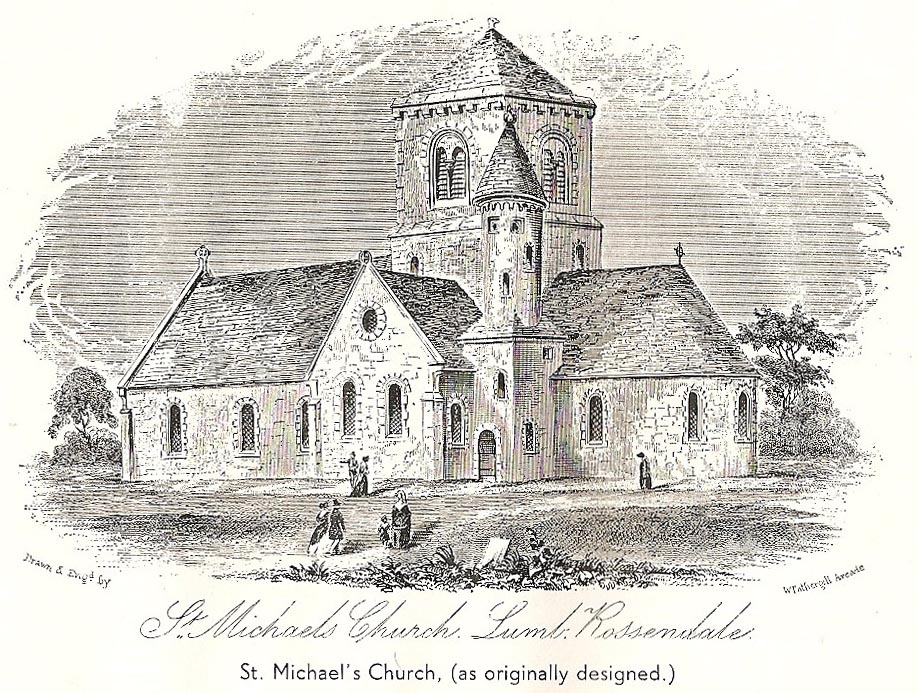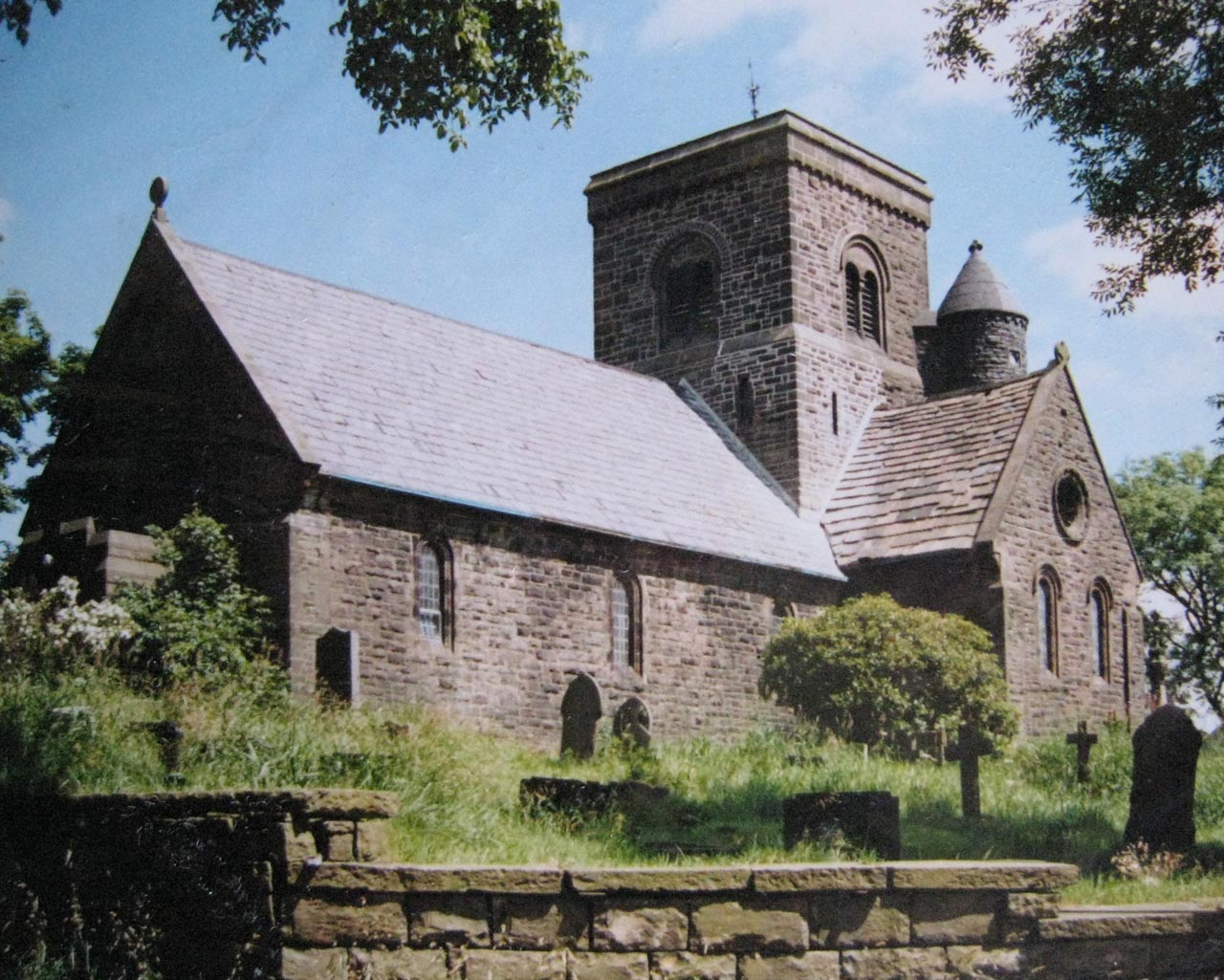 |
St Michael, Lumb |
 |
In the 1700’s Rossendale was divided into Vaccaries or Booths, Lumb was situated in Wolfenden Booth.
The Celtic meaning of Lumb is ‘Deep Pool or Wooded Valley’; the Anglo Saxon is ‘Deep Pool in the bed of a river’.
The Church and parish of St Michael arose out of the rising population of the parish of Newchurch growing to such an extent that one church was insufficient to cater for their needs.
Lumb became an Ecclesiastical District by an Order of Council of 25th February 1846. A submission in the London Gazette of 17 March 1846 defines its boundaries:
“All those parts of the townships of New Church, Higher Booths and Lower Booths, in the Parish of Whalley, in the county of Lancaster, and in the diocese of Chester, comprising within and bounded by an imaginary line, commencing at a point where a certain stream, called “Shaw Clough”, falls into Whitewell Brook, and thence along the boundary between Wofenden Booth and Bacup Booth, and, towards the north west, along the boundary between Wolfenden Booth aforesaid, and the township of Cliviger, and the boundary between the Gambleside division of Higher Booths aforesaid and the said township of Cliviger, as far as the middle of the turnpike road from New Church to Burnley, and thence, towards the south west, along the middle of such road, to a point opposite to the middle of a certain occupation road near Windybank, and thence westward along the middle of such occupation road, as far as the middle of the old highway to Burnley, and thence, towards the south west, in a straight direction to the western end of certain farm buildings called ‘Chamber Height Barn’, and thence, also towards the south west and in a straight direction, to the western end of certain other farm buildings, called ‘Higher Bank Top’, and thence towards the south east, in a straight direction to a point where a certain streamlet, flowing near Rock Barn, falls into Whitewell Brook aforesaid, and thence southward, along the western bank of the said brook, to a point where the said imaginary line commenced.”
 | |
The origins of a church in Lumb began in two cottages at Lamb Bank (now demolished).
When the Rev Kinder arrived in Lumb, there was no church or house or public school. The first service was held in the upper room of a house at Lamb Bank. On the second Sunday, the room could not hold the congregation, and Mr Kinder preached from the steps. At the close of service he announced that a Sunday School would be opened on the following Sunday. The first Sunday School consisted of nine persons, numbers rapidly increased and the tenant voluntarily removed to another house, that the lower rooms might be used as class rooms.
Extract from the Church Warden Accounts for
St Michael Lumb in Rossendale
LUMB was constituted an Ecclesiastical District and its boundaries defined, by an Order in Council dated 25th February 1846 and published in the London Gazette of March 17 in the same year.
The Rev’d Ralph Kinder was appointed first Minister of the District on the 11th April 1846.
On the 19th June 1847 a Committee was found to aid in the building of a Church, the members of the said Committee being – The Rev’d R Kinder Minister of the District; George Hargreaves Esq’re Newchurch Treasurer; John Crabtree Esq’re M. D. Warth House; Wm Samuel Lord Manufacturer Newchurch; Mr John M Cockcroft Surgeon Waterfoot and Mr James Schofield Manufacturer Baltic.
The Corner Stone of the Church was laid on the 29th September 1847, the following being an extract from a local paper of that time – “On Wednesday the 29th ult being Michaelmas day, the chief stone of St Michaels Church Lumb in Rossendale was laid by John Hargreaves Esq of Blackburn. A procession was formed at the School room consisting of the clergy and gentry of the neighbourhood and the children connected with Lumb Sunday and Daily Schools, headed by a band of music. They arrived at the site about one o’clock where a larger concourse of people was assembled than had ever been known to meet together in the hamlet of Lumb. The proceedings commenced by singing the 100th psalm; after which the Rev Incumbent offered up a suitable prayer.
The Venerable the Archdeacon of Manchester then presented the trowel to Mr Hargreaves, accompanied with a neat and appropriate address, in which he alluded to the kindness of that gentleman in giving the site for the church and burial ground. On the trowel was the following inscription:- ‘Presented to John Hargreaves Esq., on the occasion of his laying the corner stone of St Michael’s Church, Lumb, on Michaelmas day 1847’. The plate bearing the following inscription was then placed in the stone – ‘Gloria in excelsis. The corner stone of this church dedicated to the worship of the triune God, by the name of St Michael’s Church, Lumb, was laid on the 29th day of September A.D. 1847, by John Hargreaves Esq, of Newchurch and Blackburn; Ralph Kinder Incumbent, Joseph Clarke Architect’.
Mr Hargreaves having performed his part in the ceremony, the Incumbent again offered a prayer for God’s blessing on the work. The assembly was then addressed by Mr Hargreaves, the Rev’d R Kinder and the Rev’d W Brewster. The clergy, committee and gentry afterwards proceeded to the Hargreaves Arms Inn, where a collation was provided and in the evening the school children were regaled with tea in the shed of Samuel Lord Esq which was kindly lent for the occasion and were enlivened by the band which continued to play at intervals until the close of the proceedings.
The Church, which is to be an early Norman structure, with central tower, is intended to accommodate about 600. The cost will be about £2000.”
The Church was consecrated by the Lord Bishop of Manchester on Saturday December the ninth A.D. 1848 and pursuant to Act of Parliament 687 Vict: Cap. 37 Lumb then became a new Parish for all ecclesiastical purposes. The first Wardens elected were Mr John Haworth of Shaw Clough Cotton Manufacturer, for the Incumbent, and Mr John Ashworth Clough Bottom for the Parishioners. Clerk George Pilling, Sexton Elijah Piccup.
A table of fees was fixed by the Chancellor of the Diocese early in the following year as required by 687 Vict: Cap 37 sec 15.
The bell was cast at the Irish Bell Foundry Dublin by John Murphy and weighs, with clapper, 4cwt 1 qr 19lbs. It is cast to the note E natural, giving the option of 2 key notes viz: G or A, if at any time a peal should be required.
The Consecration deed and other documents are deposited at the Diocesan Registry Manchester
I hereby certify the correctness of the accounts confirmed in this and the preceding page concerning St Michaels Church Lumb & comprehending fifty lines, all in one persons hand-writing Jany 9th 1850 Ralph Kinder Incumbent of Lumb. Under Act 31 & 32 Vic C117 The Parish of Lumb became a Vicarage
 | |
Report submitted by the Inspector of Factories to Her Majesty’s Principal Secretary of State for the Home Department, dated 31st October 1849:
“In this rural district of Lumb, there is a large population of working people, with very few wealthy residents. On visiting the factories there in July I found a worthy hard-working clergyman, the Rev Ralph Kinder, incumbent of a district church, recently built, who, by dint of indefatigable perseverance and earnest zeal for the welfare of his flock had collected money enough to hire and furnish a room, where he has collected, or rather crammed about 100 children of both sexes, and to obtain the services of a man and his wife as teachers, for a miserable payment. Scanty and imperfect as the education given in such circumstances must be, had it not been for the exertion of this good man, these poor children would have been left in the same state of neglect, as far as education at school is concerned, that all previous generations at Lumb had been.”
The last great work at Lumb during Mr. Kinders ministry was the building of the National Schools, an achievement which called for much labour and self sacrifice. The first attempt was made in 1851, but at that time, the conditions laid down made the task an impossibility, and the matter stood in abeyance until 1868, when a subscription list was opened.
Extract from the Subscription Book:
1869 Church of Lumb was consecrated in 1848, but there is yet no adequate School accommodation in connexion with the Church.
At present, two cottages are rented by the Vicar, in different parts of the Parish, in which are instructed about 200 Sunday and 100 daily Scholars. They are both, however, a considerable distance from the Church, and much inconvenience arises in wet weather, and on occasions when it is desirable that all should assemble together.
It is therefore proposed to erect a new School, to accommodate about 400, on land adjacent to the Church, the estimated cost being about £1,000 for the School and £300 for the land.
St Michael’s was incorporated into St Nicholas Newchurch in 1985. The Church was made redundant 1st December 2001.
Acknowledgements
This historical compilation and the transcription of the Parish Registers would not have been possible without the help and assistance of the Revd Sue Davies, Area Dean and Team Vicar for St. Nicholas Church with St. John and St. Michael, Newchurch, together with her husband Rob Davies. They have provided invaluable help and assistance in giving me access to Parish Registers and Church archives.
Sources
A History of the Forest of Rossendale – Thomas Dowbigging
History of St Michaels Church Lumb in Rossendale – Geo. C Miller
The History of Lumb in Rossendale – Jennie Nuttall
Parish Registers are held at St Nicholas Church Newchurch:-
| Baptisms | 1847 - 2001 |
| Banns | 1904 - 1957 |
| Marriages | 1849 - 1957 |
| Burials | 1849 - 2007 |
| Rossendale Home & Contents | ©Lancashire OnLine Parish Clerks | Lancashire Home |